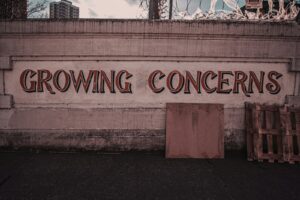The challenges of operating a small business are more complex and dynamic than ever, shaped by global economic trends, technological changes, and ever-changing customer expectations.
The top concerns that most small businesses contend with in the current business climate are:
1. Economic Uncertainty
One of the most pressing issues for small businesses is navigating an unpredictable economy. Fluctuating interest rates, inflation, and fears of a possible recession create a volatile environment that complicates decision-making. Rising operational costs further strain many small businesses’ already thin profit margins. Management is increasingly worried about cash flow management and whether they will be able to survive prolonged periods of economic downturn.
Key Strategies:
- Build an emergency fund to sustain operations during lean periods.
- Diversify revenue streams to mitigate dependency on a single source of income.
- Regularly review budgets and financial forecasts to adjust to economic changes.
2. Talent Acquisition and Retention
The labor market has become highly competitive, making it difficult for small businesses to attract and retain skilled employees. Larger corporations often offer higher salaries, better benefits, and more robust career development programs, leaving small businesses disadvantaged. Additionally, many employees now prioritize workplace flexibility, remote work options, and work-life balance…expectations that small businesses may struggle to meet due to resource constraints.
Key Strategies:
- Offer competitive but creative benefits, such as flexible schedules, wellness programs, or professional development opportunities.
- Foster a positive workplace culture to enhance employee satisfaction.
- Invest in training to upskill current employees rather than relying solely on external hiring.
3. Supply Chain Disruptions
Supply chain challenges plague small businesses with delays, shortages, and increased product costs. Unlike larger companies with significant purchasing power, small businesses often struggle to secure reliable suppliers or absorb sudden price hikes.
Key Strategies:
- Develop relationships with multiple suppliers to reduce dependency on a single source.
- Maintain higher inventory levels for critical items to prevent stockouts.
- Leverage technology to improve supply chain transparency and efficiency
4. Technology and Digital Transformation
While technology offers immense growth potential, it also presents significant challenges for small businesses. Many struggle to keep pace with rapid advancements, whether adopting e-commerce platforms, utilizing digital marketing tools, or protecting against cybersecurity threats. Implementing new technologies can be prohibitive, and lacking expertise often hinders successful integration.
Key Strategies:
- Invest in user-friendly, scalable technology solutions tailored to small businesses.
- Hire contracted IT consultants or services to ensure smooth implementation and maintenance.
- Regularly train staff on new technologies to maximize ROI.
5. Regulatory Compliance
Navigating an increasingly complex regulatory environment is a significant concern for many small businesses, depending on their industry. From tax laws and employment regulations to industry-specific compliance requirements, staying informed and compliant can be overwhelming. Non-compliance risks financial penalties and can damage a business’s reputation.
Key Strategies:
- Stay updated on changes in local, state, and federal regulations.
- Use software tools to simplify compliance tracking and reporting.
- Consult with legal or compliance experts to mitigate risks.
6. Rising Costs and Inflation
Inflation is becoming a persistent issue not only in the United States but also in many other countries. This affects everything from raw materials to employee wages. Small businesses often lack the ability to pass these costs onto customers for fear of losing them, making it very challenging to maintain profitability.
Key Strategies:
- Regularly review pricing strategies and those of the competition to reflect rising costs without alienating customers.
- Try to negotiate with suppliers for better terms or bulk discounts.
- Streamline operations as much as possible to reduce inefficiencies and control costs.
7. Changing Consumer Behavior
Consumer expectations are evolving rapidly, driven by technological advancements and societal shifts. Customers now demand personalized experiences, seamless online interactions, and socially responsible business practices. Small businesses must adapt quickly to meet these expectations or risk losing market share to more agile competitors.
Key Strategies:
- Invest in customer relationship management (CRM) tools to better understand and engage with customers.
- Utilize social media and digital marketing to build stronger connections.
- Embrace sustainable and ethical practices to appeal to socially conscious consumers.
8. Cybersecurity Threats
As businesses increasingly rely on digital tools, the risk of cyberattacks has become a significant concern. Small businesses are particularly vulnerable due to limited resources for robust cybersecurity measures. Data breaches can result in financial loss, reputational damage, and even legal consequences.
Key Strategies:
- Implement cybersecurity measures.
- Educate employees about recognizing phishing attempts and other cyber threats.
- Consider cyber insurance to mitigate potential losses.
9. Access to Capital
Securing funding remains a perennial challenge for small businesses. Traditional bank loans often have stringent requirements, while alternative funding options may involve high interest rates or unfavorable terms. Without sufficient capital, businesses struggle to invest in growth initiatives or manage cash flow during downturns.
Key Strategies:
- Explore all of the diverse funding options available.
- Maintain strong financial records to improve creditworthiness and loan eligibility.
- Build relationships with local banks or credit unions for personalized financial support.
Conclusion
While the challenges facing small businesses today are substantial, they are not insurmountable. By proactively addressing these concerns and leveraging available resources, small businesses can navigate the complexities and competitive environment and continue to thrive. Resilience, adaptability, and a commitment to innovation remain the cornerstones of long-term success.

